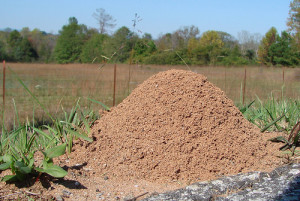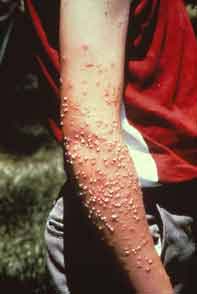Fire Ants in Virginia
The Imported Fire Ant, or simply the Fire Ant, is an introduced species that is notorious for its aggressive behavior. They can cause serious health problems for humans due to their aggressive nature and sting. Fire Ants clamp onto their targets with powerful jaws and sting their victims repeatedly. Each sting injects a dose of venom that causes a burning sensation. The stings raise itching blisters that can become infected. In sensitive victims, the stings can cause anaphylactic shock (symptoms include trouble breathing and fainting) or even death.
In addition to stings on humans, Fire Ants can cause damage to several agricultural commodities, livestock, companion animals and wildlife. They can attack and sometimes kill newborn domestic animals. Fire Ants can also destroy seedling corn, soybeans, and other crops. These insects feed on buds or fruits of many plants and may remove bands of bark from young  trees, often killing them. Additionally, the hard, cone-shaped nests of Fire Ants can result in mounds as high as two feet, making it difficult to cultivate and harvest crops from infested fields. Fire Ant mounds are unsightly hazards in yards, parks and other recreational areas where they are especially dangerous to children and pets.
trees, often killing them. Additionally, the hard, cone-shaped nests of Fire Ants can result in mounds as high as two feet, making it difficult to cultivate and harvest crops from infested fields. Fire Ant mounds are unsightly hazards in yards, parks and other recreational areas where they are especially dangerous to children and pets.
Identifying Fire Ants is difficult because they look much like ordinary ants. They are 1/8 to 1/4 inch  long and reddish brown to black in color. Fire Ants are probably best distinguished by their aggressive behavior and characteristic mound-shaped nests; when their mound is disturbed, thousands of ants will crawl out.
long and reddish brown to black in color. Fire Ants are probably best distinguished by their aggressive behavior and characteristic mound-shaped nests; when their mound is disturbed, thousands of ants will crawl out.
Avoid being stung by Fire Ants. Being aware of your surroundings at all times will enable you to avoid Fire Ant mounds. Some Fire Ant mounds are very small and difficult to detect, therefore taking  the time to survey an area is important. If Fire Ants do crawl onto your skin, they first bite with their mandibles in order to anchor for the thrust of the sting. As soon as you feel this pinching sensation, quickly sweep the ants off before they actually sting, thus reducing the likelihood of additional injury.
the time to survey an area is important. If Fire Ants do crawl onto your skin, they first bite with their mandibles in order to anchor for the thrust of the sting. As soon as you feel this pinching sensation, quickly sweep the ants off before they actually sting, thus reducing the likelihood of additional injury.
Tips for treating fire ant stings:
- Brush any remaining ants off your body to stop further bites
- Elevate the affected area to prevent swelling
- Tighten skin around the stung site to prevent venom from spreading
- Rinse the sting with cold water
- Watch for symptoms of an allergic reaction
Fire ants in northern Virginia and the surrounding areas can also damage the landscaping of your home or commercial property by building the mounds their colonies use for nesting.
Tips to prevent infestations of fire ants:
- Have a professional treat the inside and outside of your home for pests
- Consult neighbors who have fire ants to prevent them from spreading to your property
- Check carefully throughout your property for fire ant mounds
- Seal any holes around doors, windows, or the foundation of your home that could allow them entry to your home.
A new colony begins with a “nuptial flight” of winged males and winged females, usually on a warm, spring day. After mating occurs, males drop to the ground and die. Females seek out nesting sites and burrow underground. A new queen sheds her wings and lays 12 to 24 worker eggs, which she tends constantly. Upon hatching, the workers, all of which are sterile females, take over all colony functions except reproduction, while the queen only mates and lays eggs. She can produce more than 200 eggs per day.
Natural dispersal occurs during the mating process when a queen starts a new colony. Fire Ants spread slowly through natural dispersal, but they can travel longer distances when colonies are moved in soil, plants with roots and soil attached, nursery stock, grass, sod, hay, logs, beehives and any equipment that contains soil.
Fire Ant colonies vary in size, but a mature, three-year-old colony typically contains 250,000 workers, which are sterile females, and hundreds of reproductive males and potentially reproductive females. A colony population can grow to 300,000 ants. In addition to single-queen colonies, many Fire Ant colonies have multiple queens, increasing many fold the number of mounds in an infested area.
Fire Ant brood (larva) is sensitive to temperature and humidity. Worker ants move the brood up high when it is wet. That’s why you see tall mounds after rains. When conditions are dry, the workers move the brood deeper to more humid chambers and you may see no mounds at all. Mounds can extend as much as four feet below the surface.
Control of Fire Ants is made difficult by the protective behavior of the workers that guard the queen. If the colony is disturbed, workers will hurriedly carry the queen to a safe location where the queen will begin a new colony. Therefore, the best control is not a method that will merely kill workers, but one in which a bait is applied that will be taken back to the nest by foraging ants where it will either kill the queen or render her sterile. Baits combine a food to attract the ants with an insecticide or insect growth regulator (a pesticide that works by disrupting the ants’ reproductive system). Although baits are slow-acting, they are often the best way to reach the queen and eliminate the colony. Many times, using insecticides that kill on contact will simply force the colony to move to a new location. Since the worker Fire Ants move the queen in order to protect her, these types of treatments are usually ineffective in killing the colony. Individuals applying any treatment should read the insecticide labels closely and follow all directions. You may wish to consider discussing your Fire Ant treatment needs with a pest control professional.


































































